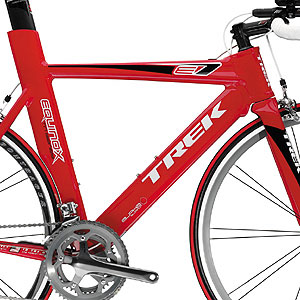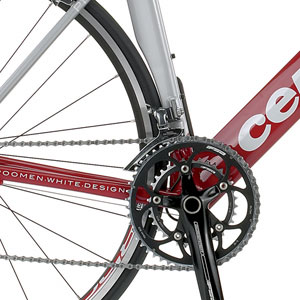Giant, Leader wrap entry-level tri
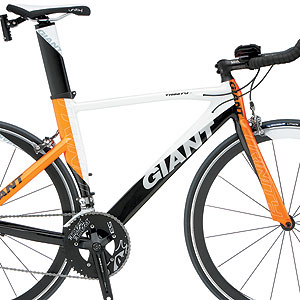
We'll wrap our look at entry level tri bikes by considering the offerings by two companies making bikes in Taiwan: one very large, the other very small. But both companies make bikes you'll want to read about.
Giant
Go back, upwards of a decade, you'll find two bikes by Giant pointed toward triathletes. These were the TCR Aero I and Aero II. These bikes were not only geometric nightmares, they were spec'd nonsensically. One had a full tri set up, the other had more of a road set up with clip-ons mounted on a tri frame.
Or was the other one the tri set up mounted on a road frame? It was all a confusing muddle, and Giant's eventual high-end bike—the Trinity Composite—was not much better, at least for triathletes.
This company has come a long way since then. It makes two frames, the all-aluminum Trinity, and the Trinity Alliance: featuring the aluminum-carbon matrix that it calls its "Alliance" technology. These frames are geometrically identical, and are also geometrically appropriate. And in true Giant style, the values are potent.
The Trinity Alliance bikes suffer from an image problem, in that they are a Reese's Peanut Butter Cup of aluminum and chocolate, er, carbon, and while the frame is just flat-out fantastic, most triathletes paying at least $2500 can't (it appears) reconcile themselves to a frame made of anything but one-hundred percent carbon. Too bad.
But we'll get to the Trinity Alliance later. For now, it's the Trinity (without the Alliance) and these are all-aluminum frames. In their competitive set (bikes under $1900) they're in amongst their peers. All the bikes in this category (links to the QR, Felt, Cervelo, Trek and Fuji alternatives are at the end of this article) are aluminum.
Trinity 1
I'll break the suspense. This is the Giant you want, if you're choosing between the two Trinity models. The frame has rear entry dropouts, aero seat tube and post, sensible tri geometry and is made in what might be the premier bike factory in the World. When you think of the most august bike brands in Europe, like Colnago, and the most respected brands in America, like Trek, companies like these are very picky about the strategic partners they choose. And Giant is such a partner. Consider the TT bikes both Rabobank and Columbia are riding, notwithstanding the fact that Columbia is sponsored by Scott (a company that has a fine TT bike in the Plasma). The TT bikes are made by Giant (though the for-sale bike is still a work in progress).
But Giant's real strength is in its ability to churn out low and mid priced bikes, bike after bike, and have them be perfect, and priced dynamically. Enter the Trinity 1.
The genesis of this bike's geometry was a trip to a F.I.S.T. Tri Bike Fit Workshop by the then-product manager of Giant's road bikes. The geometries that came out of that experience found their way to the Trinity Alliance, and then to the Trinity. The seat angles are mid-steep at 78°, and the head tubes are reasonable lengths given the seat angles. These Giant bikes are much easier to fit aboard than any all-carbon TT bike that Giant is now, or ever has, made. These are easy bikes to ride.
Thematically, the geometry of the Trinity is in between two styles. It's not as "long and low" as the bikes made by Cervelo, Felt, QR, and Kestrel, and it's not as "tall and narrow" as the tri and TT bikes made by Cannondale and Scott. The Trinity models are a nice middle ground that'll fit a lot of riders.
This bikes sells for $1725 complete, and features a Shimano 105 gruppo, with some cross- or down-specs, namely, a Race Face Cadence crankset and Tektro brake calipers. It's got a set of Visiontech clip-ons as the aerobar and a no-name but, one assumes, acceptably functional wheelset.
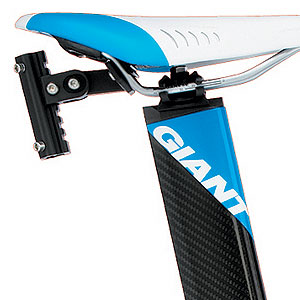
A nice feature of Giant's TT bikes is a seat post that has the hardware mounted on a set of "ways" that can slide a centimeter fore or aft from center (it is pictured adjacent). This means the bike is easily set up to ride at 80° or 81° if that's the config that floats your boat.
Finally, like a date that shows up with an unexpected bouquet of flowers, Giant adds a behind-the-seat bottle cage holder. The bike does have the water bottle bosses on both down and seat tube, so, the rider could do what I do on my race bike. I do put a bottle back there, but I fill it with my spare tube, tools, CO2 cartridge and inflator.
Trinity 2
This bike I would pass by. I'm breaking a rule in suggesting this, because I almost always favor getting the best frame for the least price—sort of like buying the worst house in a nice neighborhood (it's not the prettiest, but you'll get the best value).
For example, I'll certainly recommend the lesser priced Trinity Alliance over the pricey version, because you get the same frame for less money. But in the case of the bargain-priced Trinity Alliance, the gruppo slots in slightly above the one on the Trinity 1 described above. The Trinity 2 is outfitted with Shimano Sora. This group should not be sold on bikes selling for $1400, which is the price point of the Trinity 2.
Sora is a 9sp group, and almost certainly everything you buy for your Giant—spare training wheels, new drivetrain parts, race wheels—will be 10sp. The cycling world has made the switch to 10sp. There's no turning back.
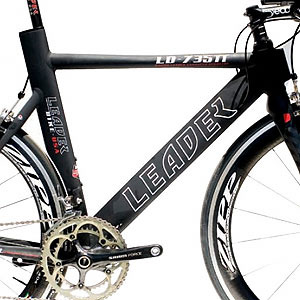
Leader
This company is a direct seller. Your retailer's loss is your gain. No middleman here. This makes Leader an intriguing option and, if you just look at what you pay and what you get, its bikes are certainly worth a look.
Now, this company is, in its outward presentation—how best to put it?—rustic, compared with the bigs. If you visit the website of, say, Specialized, or Cervelo, you see a lot of polish in the presentation of the bikes; the photography; web design. The marketing text displayed by these larger, long-established companies is written by folks whose only or major duty is to wordsmith.
Don't think I'm looking down my nose. You want rustic? You should've seen my own bike company in my first several years in business. I was the king of rustic (still am, according to the wife). I gloried in my rusticity. When you start from scratch, self-funded, you're VP of wordsmithing; you're VP of janitorial engineering; you're VP of having a toilet flushed on your head every damned day of your life from any number of directions. It's you, the owner, president, and VP of everything. Welcome to the life of the small businessman.
Fortunately, a Leader customer doesn't hop aboard a website and ride. He hops aboard a bike and rides. So you don't have to win website awards, you just have to build compelling bikes. And Leader does deserve a look, for the reasons I will describe.
This is not a new company, Leader bicycles are celebrating a decade in business. There used to be another bike company of that name doing business in Taiwan, but Leader the Asian bicycle factory ceased operations in 2002, so this is the one and only Leader bicycle company.
Leader LD-735TT
The bike I'm talking about here sells for $1814 complete. It sells for that particular price because I spec'd it that way (if you spec it another way, the price may be different). And that's one really nice element to this company. Often, if you buy a tri bike below $2000 (heck, below $4000) there's a lot of stuff you have to change. Not so with Leader. I'll describe further when I get to the parts.
The frameset is aluminum, just as are all the other bikes in this category of tri bikes for sale between $1400 and $1900. As you can see from the adjacent picture, the frame has aero features. Is it aero? I have no idea. But it certainly has the features, including a welded rear wheel cutout, and rear entry dropouts with adjustable set screws.
The frame itself is made in Taiwan, out of 6066 alloy, rather high-end for a bike of this price. The fork is carbon throughout, steerer included, weighing in at 370g, again on the high-end side for an entry-level priced bike.
What it does not have is an aero seat post, and nowadays that's becoming a requisite feature. Who knows if aero posts are really more aero? But, then, who knows if a carbon frame is faster or more comfortable than an aluminum frame of the same shape? These questions are immaterial. There just are some features that sell, and carbon outsells aluminum, and aero shapes outsell round shapes—including the seat post.
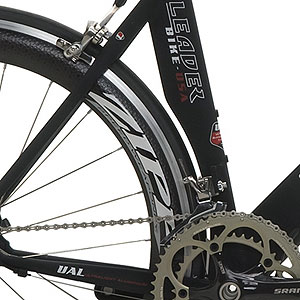
The geometry is quite good. I think the closest match throughout the size run is Cervelo's P2. My only beef is that all the sizes use 700c wheels, and I'd always choose 650c in 50cm or lower.
Now, here is where it gets interesting. The gruppo that comes on this $1814 bike is SRAM Rival. Generally, you don't find an entire group complete on a tri bike this price—usually there is a lot of scrambling done by the bike's product manager to find bottom brackets, chains, cassettes, brake calipers, cranks, to sub in ("cross-spec" they call it, when it's typically "down-spec" in practice). Not so this bike, and SRAM Rival is a very nice group for a tri bike this price, and just about everything on a Rival group, including SRAM's excellent TT brake levers and bar-end shifters, comes on this bike.
Furthermore, I can choose a crank with either 130mm or 110mm bolt pattern, which means if I want 50×34-tooth chainrings, I can have them. I can choose the crank length I want, and a cassette anywhere from 11-23 to 12-27.
The wheels are Bontrager Aero Race Select, but for an extra $45 I can upgrade to Bontrager Race Light. The saddle I'm choosing is a Selle Italia SLR T1, which I can almost guarantee you won't find spec'd on any bike below $4000 in price. The aerobars are Profile Design T2 + Cobra extensions and, again, those Cobra extensions are a spec you'll see on very few bikes below, say, $3000.
Now, if I—personally—was to buy certain of the bikes in this price category or, frankly, in the price category above it, I'd have to immediately start making changes, because every place I contact the bike (saddle, armrests, extensions) must be comfortable for me, and these original equipment parts almost always aren't. Further, I'm going to have to change the gearing to suit my ability and the terrain around where I live and where I'll likely race. I'm talking probably $400 or $500 in upgrades. Not so the parts on this Leader.
That's why bikes like this, by Leader, are compelling options. The automotive industry gives you two ways to buy a car: off the lot; and special order. I buy my cars special order, because I can get them exactly as I want them. They don't cost any more, but they have everything I want and nothing I don't want. Bike companies don't do that. Changes are made at the retailer level. But usually those sorts of upgrades are not very negotiable on entry level bikes, because there isn't enough profit. At a higher price point, the retailer may be more willing to sub in some personalized items at no additional charge.
This makes life a little tougher for companies like Leader at the higher price points. But in the sub-$1900 category, that seems to me right in Leader's wheelhouse.
The good: Leader ships bikes in 48 hours of receiving the order, whereas your favorite auto manufacturer takes 6 or 8 weeks to build your special order car. The bad: I can see, test drive, sniff, taste a car pretty much like the one I'm going to special order at the dealership. Not so your Leader bike.
So perform your own due diligence before you buy, realize the determination of certain things—whether your bike is straight and aligned, whether the surfaces are faced and prepped properly—are yours to make, not your retailer's to make, upon taking possession of your new bike. The onus is on your to make sure your Leader is ready for the road. Are you up to the task?



